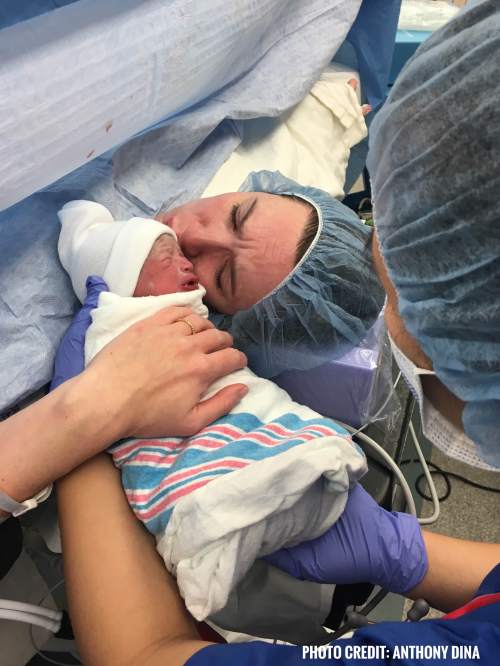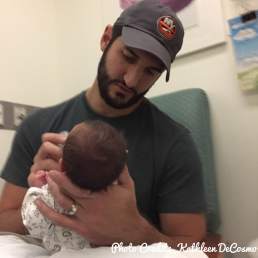Pregnancy, Cholestasis, Preeclampsia, and a Miracle …. Dec 12th was supposed to be the day my grandson was to be born into this world by C-section at 37 weeks gestation.
My daughter Elizabeth’s High-Risk OB Dr. determined that 37 weeks was as far as he could let the pregnancy go without risking many complications for mother and baby.
Elizabeth started her pregnancy being seen by a High-Risk OB Dr. because she has Crohn’s Disease and Sjogren’s syndrome. Two autoimmune diseases that can complicate pregnancy numerous ways.
The end of the first trimester Elizabeth and her husband were given the news that their baby could have complications with his heart because of Elizabeth’s Sjogren’s syndrome. They were told that if there were to be heart complications they would show up between the end of the first trimester to the end of the second trimester. Every ultrasound was scrutinized. A trying time for the expectant parents, nerves were raw as they leaned on their faith. They chose to believe that all would be fine with their child’s heart.
Everyone drew a sigh of relief when the second trimester came to a close without any sign of heart complications for the baby.
The third trimester brought on an onslaught of itchiness all over Elizabeth’s body. The last week of September my daughter asked me if I had experienced itchiness during any of my three pregnancies. Definitely not because I would absolutely remember if that happened to me. She told me the itch was all over her body and increasing in severity by the day. I told her that was not a normal pregnancy problem and go see her Dr. ASAP! She was only 27 weeks pregnant and I suspected something was going awry.
We were so glad that we had her baby shower three months before her due date of Dec 30th. We originally planned it for Oct 1st because her brother was getting married Nov 5th. It definitely worked out in hindsight because Elizabeth’s itchiness and what was to follow in her pregnancy.
My gut feeling was that her auto immune diseases were complicating the pregnancy. I did not feel qualified to have an opinion on whether or not it was in any way normal to be itchy all over since I do not have either of those medical conditions. Although her cousin Courtney suspected she was experiencing a condition called cholestasis, I wanted my daughter to have blood work to confirm or rule out anything related to the itchiness all over her body.
What is obstetric cholestasis?
Obstetric cholestasis is a condition of the liver which occurs in some pregnant women. Cholestasis means there is a reduced flow of bile down the bile ducts in the liver. Some bile then leaks out into the bloodstream, in particular, the bile salts. These circulate in the bloodstream and can cause symptoms.
What are the symptoms of obstetric cholestasis?
Typically, symptoms occur after 24 weeks of pregnancy when the hormone levels are at their highest. Sometimes it develops earlier in pregnancy.
Severe itch without any skin rash is the most common symptom. The itch can be all over, but it is often worst on the hands and feet. Commonly, itch is the only symptom. It tends to get worse until you have the baby. The itch can become severe and affect sleep, concentration, and mood. It can become distressing. Although obstetric cholestasis does not cause a rash, the scratching caused by severe itching can cause visible marks on the skin.
Elizabeth’s Dr Appt (in her 28th week of pregnancy, first of week of October) resulted in her immediately being diagnosed with suspicion of cholestasis pending confirmation by her blood work that would take a week to receive the results. Her High-Risk OB immediately began treating her for cholestasis with drug intervention. My daughter was so itchy that she was scratching her entire body with a hair comb!
The blood results came back in her 29th week of pregnancy and confirmed the presence of a cholestasis condition and a very bad case. Her bile acids were extremely high as well as her liver enzymes. Elizabeth’s Dr. increased her dosage of meds and started monitoring her even more closely. She had 2 Dr. visits a week, ultrasounds, blood pressure monitoring/logging, constant dialogue with the Dr via tests, email, and phone calls.
Elizabeth’s blood pressure was elevated during her 29th week of pregnancy and her feet began to fill with fluid. The Dr. suspected Preeclampsia and tested her by measuring proteins in her urine and monitoring her blood pressure throughout her days.
The Preeclampsia was confirmed in her 30th week of pregnancy in addition to her Cholestasis condition driving her crazy with severe itching all over her body.
“Preeclampsia (pre-e-CLAMP-si-a) is a condition unique to human pregnancy. It is diagnosed by the elevation of the expectant mother’s blood pressure usually after the 20th week of pregnancy. According to guidelines released by the American College of Obstetricians and Gynecologists, the diagnosis of preeclampsia no longer requires the detection of high levels of protein in the urine (proteinuria). Evidence shows organ problems with the kidneys and liver can occur without signs of protein, and that the amount of protein in the urine does not predict how severely the disease will progress. Prior to these new guidelines, most healthcare providers traditionally adhered to a rigid diagnosis of preeclampsia based on blood pressure and protein in the urine.
Preeclampsia is now to be diagnosed by persistent high blood pressure that develops during pregnancy or the postpartum period that is associated with high levels of protein in the urine OR the new development of decreased blood platelets, trouble with the kidneys or liver, fluid in the lungs, or signs of brain trouble such as seizures and/or visual disturbances.
Important symptoms that may suggest preeclampsia are headaches, abdominal pain, shortness of breath or burning behind the sternum, nausea and vomiting, confusion, heightened state of anxiety, and/or visual disturbances such as oversensitivity to light, blurred vision, or seeing flashing spots or auras. Preeclampsia and related hypertensive disorders of pregnancy impact 5-8% of all births in the United States.
Most women with preeclampsia will deliver healthy babies and fully recover. However, some women will experience complications, several of which may be life-threatening to mother and/or baby. A woman’s condition can progress to severe preeclampsia very quickly.
Preeclampsia and other hypertensive disorders of pregnancy can be devastating diseases, made worse by delays in diagnosis or management, seriously impacting or even killing both women and their babies before, during or after birth.”
Having both Cholestasis and Preeclampsia put Elizabeth and her child at extreme risk. The Dr. told her that she needed to feel her baby move at least 10x every 90 minutes. If she did not feel him 10 times she needed to get in the car and get to the hospital ASAP. Every minute counted. Elizabeth felt the heavy responsibility of monitoring her baby’s life and was having trouble sleeping in conjunction with insane cholestasis itching.
It was touch and go whether Elizabeth would be able to attend her brother’s wedding on Nov 5th which placed her pregnancy in her 32nd week. The Dr. said he could take the baby as early as the 32nd week if he deemed necessary.
The Dr. gave her the go ahead to attend her brother’s wedding that was one hour away from the hospital she was going to deliver her baby at. Her liver enzymes and bile acids were on their way down and her itchiness was not increasing. She needed to monitor her blood pressure frequently and make sure the baby was moving 10 times in 90-minute cycles. Again a very big responsibility to feel like you hold your child’s life in your grasp. We made a game out of taking blood pressure readings while hanging out in the hotel the night before the wedding. Making light of a very serious situation. Thankful that she did not have to miss her brother’s wedding.
The following two weeks there was bi-weekly ultrasounds and Dr. visits. Elizabeth kept a blood pressure log in her iPhone. Her 34th week the Dr asked to see her blood pressure log and admitted her into the hospital on the spot for observation. They did a liver enzyme test and found her enzymes were off the charts and blood pressure consistently high. The baby’s heart was monitored as well. It was decided the baby would be delivered that night or the very next day.
While delivering the baby and cutting the cord it was discovered that there was only a drop of blood left in the cord, not enough for a cord blood sample to be stored.
When I went to the recovery room to see my daughter she told me through tears that it was a very close call. If the baby was not delivered that day he most likely would have not made it in utero past the following 24 hours. The placenta was found to be a mess and ceasing to support the baby through the cord.
We call our grandson the “Miracle Baby”. Born at 34 weeks gestation and weighing 4lbs. 3oz. 17 ¼ inches long. He has overcome so many obstacles and is a thriving little fighter Preemie! Anthony Joseph spent 18 days in the NICU. He gained a half pound in only three days while at home nursing every 2 hours.
The purpose of this post is to make people aware of Cholestasis and Preeclampsia. I had three pregnancies and never experienced either of those conditions so I was unaware of the signs and symptoms my daughter was experiencing.
Both conditions are very serious and if not caught and managed very closely can be deadly to mother/child.




